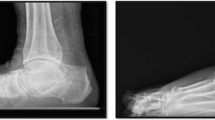Abstract
Purpose
The purpose of this study was to present the functional, radiological, and quality of life outcomes of a series of stage III adult-acquired flatfoot deformity corrections using an original operative approach based on minimal incision surgery (MIS).
Methods
Sixty-two patients (67 feet) with a symptomatic stage III flatfoot deformity were treated using a modified double arthrodesis by MIS. The mean age was 63 years (range, 50 to 81) and the mean follow-up was 6.6 years (range, 3.2 to 11.5). Clinical, radiological, American Orthopaedic Foot and Ankle Society Hindfoot score (AOFAS score), quality of life (SF-36), and satisfaction scores were collected retrospectively.
Results
The mean AOFAS score improved by 54.27 (95% [CI], 57.27–51.3; P < 0.0001), and the SF-36 improved by a mean of 17.5 points (95% CI, 1.4–20.9) in the physical component summary (PCS). Deformity correction was confirmed by a significant improvement in the x-ray measurements (six angles). Bony union was observed in 89.5% of cases (60/67). In all, nine patients (13.4%) needed a secondary surgery: three for talonavicular nonunion, four for progression of the flatfoot deformity, and two for screw protrusion. No cases of superficial infection, wound dehiscence, or avascular necrosis of the talus were observed.
Conclusion
The present series represents the largest study of stage III flatfoot correction using MIS with a mid- to long-term follow-up. Because the data showed clinical and functional improvement after surgery with fewer complications, this technique may be ideal for patients at risk of complications.

Graphical abstract





Similar content being viewed by others
References
Johnson KA, Strom DE (1989) Tibialis posterior tendon dysfunction. Clin Orthop Relat Res 239:196–206
Hyer CF, Galli MM, Scott RT, Bussewitz B, Berlet GC (2014) Ankle valgus after hind-foot arthrodesis: a radiographic and chart comparison of the medial double and triple arthrodesis. J Foot Ankle Surg 53(1):55–58. https://doi.org/10.1053/j.jfas.2013.02.018
Pell RF IV, Myerson MS, Schon LC (2000) Clinical outcomes after primary triple arthrodesis. J Bone Joint Surg Am 82(1):47–57. https://doi.org/10.2106/00004623-200001000-00006
Brilhault J (2009) Single medial approach to modified double arthrodesis in rigid flatfoot with lateral deficient skin. Foot Ankle Int 30(1):21–26. https://doi.org/10.3113/FAI.2009.0021
Tisdel CL, Marcus RE, Heiple KG (1995) Triple arthrodesis for diabetic peritalar neuroarthropathy. Foot Ankle Int 16:332–338. https://doi.org/10.1177/107110079501600604
Wukich DK, Crim BE, Frykberg RG, Rosario BL (2014) Neuropathy and poorly controlled diabetes increase the rate of surgical site infection after foot and ankle surgery. J Bone Joint Surg Am 96(10):832–839. https://doi.org/10.2106/JBJS.L.01302
Bibbo C, Anderson RB, Hodges DW (2001) Complications of midfoot and hindfoot arthrodesis. Clin Orthop Relat Res 391:45–58. https://doi.org/10.1097/00003086-200110000-00007
Carranza-Bencano A, Tejero García S, Fernández Torres JJ, Del Castillo-Blanco G, Alegrete-Parra A (2013) Isolated subtalar arthrodesis through minimal incision surgery. Foot Ankle Int 34(8):1117–1127. https://doi.org/10.1177/1071100713483114
Lee DL, Mulder GD (2009) Foot and ankle surgery: considerations for the geriatric patient. J Am Board Fam Med 22(3):316–324. https://doi.org/10.3122/jabfm.2009.03.080122
Carranza-Bencano A, Tejero S, Fernández Torres JJ, Del Castillo-Blanco G, Alegrete-Parra A (2015) Isolated talonavicular joint arthrodesis through minimal incision surgery. Foot Ankle Surg 21(3):171–177. https://doi.org/10.1016/j.fas.2014.11.003
Galli MM, Scott RT, Bussewitz B, Hatic S II, Hyer CF (2014) Structures at risk with medial double hindfoot fusion: a cadaveric study. J Foot Ankle Surg 53(5):598–600. https://doi.org/10.1053/j.jfas.2014.03.001
Phisitkul P, Haugsdal J, Vaseenon T, Pizzimenti MA (2013) Vascular disruption of the talus: comparison of two approaches for triple arthrodesis. Foot Ankle Int 34(4):568–574. https://doi.org/10.1177/1071100713479318
Mulfinger GL, Trueta J (1970) The blood supply of the talus. J Bone Joint Surg (Br) 52(1):160–167
Gelberman RH, Mortensen WW (1983) The arterial anatomy of the talus. Foot Ankle 4(2):64–72
Rohm J, Zwicky L, Horn Lang T, Salentiny Y, Hintermann B, Knupp M (2015) Mid- to long-term corrective hindfoot fusions in 84 patients with rigid flatfoot deformity. Bone Joint J 97-B(5):668–674. https://doi.org/10.1302/0301-620X.97B5.35063
Smith RW, Shen W, Dewitt S, Reischl SF (2004) Triple arthrodesis in adults with non- paralytic disease. A minimum ten-year follow-up study. J Bone Joint Surg Am 86(12):2707–2713. https://doi.org/10.2106/00004623-200412000-00018
Cody EA, Younger A, Cerrato RA, Johnson AH (2019) The flatfoot through a pinhole: do it percutaneously! Tech Foot Ankle Surg 18(4):156–159. https://doi.org/10.1097/BTF.0000000000000247
Hughes AM, Gosling O, McKenzie J, Amirfeyz R, Winson IG (2014) Arthroscopic triple fusion joint preparation using two lateral portals: a cadaveric study to evaluate efficacy and safety. Foot Ankle Surg 20(2):135–139. https://doi.org/10.1016/j.fas.2014.02.001
Jagodzinski NA, Parsons AM, Parsons SW (2015) Arthroscopic triple and modified double hindfoot arthrodesis. Foot Ankle Surg 21(2):97–102. https://doi.org/10.1016/j.fas.2014.10.001
Lui TH (2017) Arthroscopic triple arthrodesis in management of chronic flatfoot deformity. Arthrosc Tech 6(3):e871–e877. https://doi.org/10.1016/j.eats.2017.02.020
Coughlin MJ, Grimes JS, Traughber PD, Jones CP (2006) Comparison of radiographs and CT scan in the prospective evaluation of the fusion of the hindfoot arthrodesis. Foot Ankle Int 27:780–787. https://doi.org/10.1177/107110070602701004
Author information
Authors and Affiliations
Corresponding author
Ethics declarations
Conflict of interest
The authors declare that they have no conflict of interest.
Ethical approval
Ethical approval for this study was obtained from our institution’s ethical review committee (CEI:2013PI/303).
Additional information
Publisher’s note
Springer Nature remains neutral with regard to jurisdictional claims in published maps and institutional affiliations.
Level of evidence: Level IV, case series
Electronic supplementary material
Supplementary 1
Graphic 1 Preoperative AOFAS score; postoperative AOFAS scores (n = 67). (JPG 14 kb)
Rights and permissions
About this article
Cite this article
Tejero, S., Carranza-Pérez-Tinao, A., Zambrano-Jiménez, M.D. et al. Minimally invasive technique for stage III adult-acquired flatfoot deformity: a mid- to long-term retrospective study. International Orthopaedics (SICOT) 45, 217–223 (2021). https://doi.org/10.1007/s00264-020-04724-5
Received:
Accepted:
Published:
Issue Date:
DOI: https://doi.org/10.1007/s00264-020-04724-5




